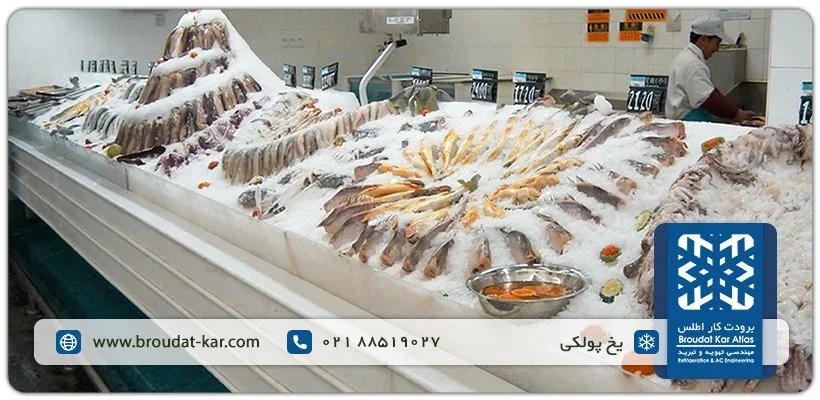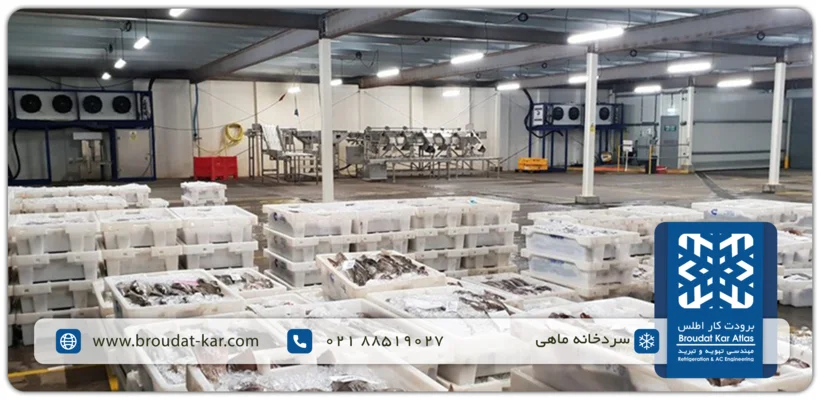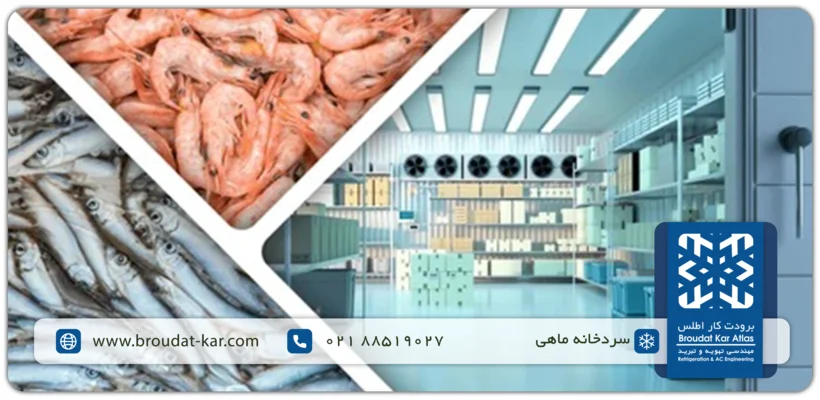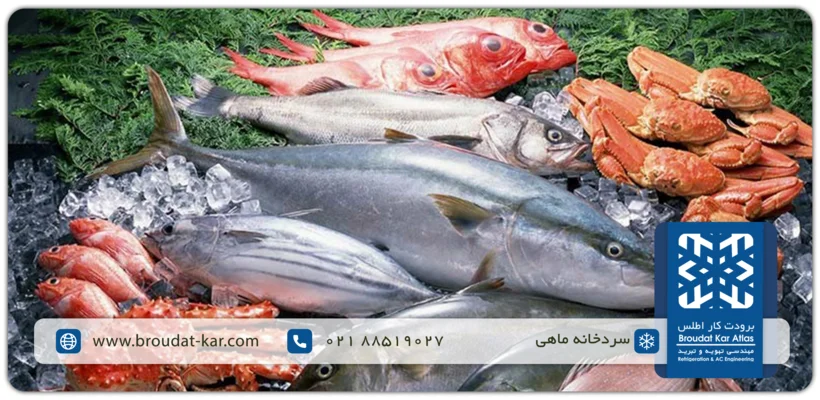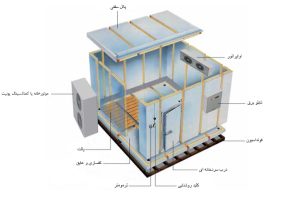Fish and Shrimp Cold Storage Systems – Preserving Freshness
Fish and shrimp cold storage facilities play an important role in preserving the freshness of aquatic products from catch to consumption. These facilities slow down the spoilage process, which is primarily caused by protein denaturation, fat structure changes, and cell tissue moisture loss. The Food and Agriculture Organization of the United Nations (FAO) sets standards for storing frozen fish, considering factors such as species, product type (whole, filleted, or processed), and storage duration. Standard temperatures vary by country; for instance, England mandates -30 degrees Celsius, while Iran’s range is typically between -18 and -20 degrees Celsius, with lower temperatures recommended for longer storage periods.
In the middle east countries, various aquatic species are available, and proper conservation measures must be followed to maintain product quality and freshness, ultimately enhancing customer satisfaction.
Diverse Fish Species of Iran
Iran boasts a rich array of fish and shellfish species, sourced from the Caspian Sea, inland waters, Persian Gulf, and Oman Sea. These aquatic resources serve as vital components of Iran’s food industry, offering a diverse range of options for consumption and cultivation.
Preserving Fish Freshness: The Vital Role of Fish Cold Storage
Research indicates that fish sourced from tropical waters exhibit longer shelf lives compared to those from colder waters due to the presence of natural bacterial flora. Gram-negative mesophilic bacteria, which are more active in warmer conditions, dominate in tropical waters, while Gram-negative psychrophiles are the main culprits of fish spoilage. Upon entering cold storage, the transition of bacteria from mesophilic to psychrophilic states is slowed due to the low temperatures, extending the fish’s freshness and quality.
Preserving Freshness: Best Practices for Handling Freshly Caught Fish
Effective handling of freshly caught aquatic animals is crucial to maintain their quality from the moment of capture. Below are essential care measures focusing on refrigeration processes:
On-Board Care
Fish should be promptly processed after catch, with modern boats employing washing and icing methods for quick preservation. Crustaceans like lobsters are typically kept alive, while shrimps are stored in ice or low-temperature brine.
Icing
Lowering storage temperature delays bacterial and enzymatic activities, slowing spoilage. Clean ice is crucial; using chlorinated or potable water is recommended for ice production. Flake ice makers are common on ships.
Salt Water Icing
Adding salt to water for ice production allows for lower temperatures close to the freezing point of fish. A 3% sodium chloride brine solution produces ice at about -1°C for storage.
Use of Preservatives
The use of antibiotics in aquatic animals is prohibited and not recommended for any purpose.
Crating at Sea
Boxing fish at sea reduces pressure, minimizing physical damage and increasing efficiency. Immediate boxing by size and species ensures uniformity and firmer texture, enhancing fillet quality.
Measures for On-Land Storage
Upon reaching land, proper ice usage and adherence to sanitary practices are vital for continued freshness during processing, packaging, and distribution. Following health and quality protocols is essential for delivering high-quality fish to consumers.
Assessing Fish Quality: Visual Indicators of Freshness
Visual assessment remains a primary method for gauging fish quality and freshness. While some regions increasingly rely on physical and chemical tests for accuracy, visual inspection remains valuable. Quality assessment based on appearance varies by species, with general guidelines available in fish quality tables.
Fish quality appearance evaluation table
| Row | Factor | Good Quality | Poor Quality |
| 1 | Eyes | Bright, transparent, often protruding | Cloudy, often pink, sunken |
| 2 | Odor | Sweet, fishy, similar to seaweed | Stale, sour, presence of sulfides, amines |
| 3 | Color | Bright, characteristic of species, sometimes pearlescent at correct light angles | Faded, dull |
| 4 | Texture | Firm, may be in rigor, elastic to finger pressure | Soft, flabby, little resilience, presence of fluid |
| 5 | Belly | Walls intact, vent pink, normal shape | Often ruptured, bloated, vent brown, protruding |
| 6 | Organs (including gills) | Intact, bright, easily recognizable | Soft to liquid, gray homogeneous mass |
| 7 | Muscle tissue | White or characteristic of species and type | White flesh pink to gray, spreading of blood color around backbone |
Upon unloading from the fishing vessel, intermediaries typically assess and categorize fish based on species, size, and quality criteria. Pricing is determined according to market demand and the perceived quality. Additionally, fish may undergo inspection by private or government agencies to ensure adherence to health and sanitary standards.
Packaging Solutions for Fresh Fish
Fresh fish is typically packaged using polyethylene trays, aluminum trays, polystyrene foam trays, and polyethylene bags. Containers with good heat conductivity are preferred for packing fish before cooling. Without pre-cooling, the product may not reach optimal temperature levels.
Above-Zero Cold Storage for Fresh Fish
The maximum shelf life of fish and shrimp in cold storage varies depending on their species. But in general, it can be said that fresh fish can be kept for 7 to 15 days in frozen boxes in an industrial fish freezer at a temperature of +1°C. Of course, these shelf-life values are highly dependent on the conditions of freezing and transportation. It is better to keep fresh and frozen fish at this temperature for about 7 days. Also, keep in mind that all these time periods include the time from taking the fish out of the water to consuming it.
Above-Zero Fresh Fish Cold Storage Specifications
The above-zero fish cold storage should maintain a temperature of +1°C and a relative humidity of 90%. Controlled aeration limits ice melting, crucial for maintaining fish quality. Proper drainage and easy-to-clean surfaces are essential for hygiene and preservation of fish quality.
Factors Affecting Quality in Fish and Shrimp Cold Storage
Changes in taste, texture, and appearance during storage result from moisture loss, oxidation, and enzyme activity. Factors include fish type, temperature stability, humidity levels, and packaging. Establishing protocols based on these factors ensures quality and safety.
Impact of Fish Species on Storage in Industrial Cold Storage
The species of fish significantly influences shelf life in industrial cold storage. High-oil fish like salmon and tuna have shorter frozen shelf lives due to oil and pigment oxidation. However, some high-oil fish are surprisingly resistant to oxidation in frozen conditions, while low-oil fish can be stored in sub-zero freezers for months with minimal quality loss.
Freezing Methods for Fish and Shrimp
The method of freezing fish and shrimp significantly impacts their quality, appearance, and production costs. Industrial freezing typically employs blast freezers or plate freezers, while quick freezing methods like Individual Quick Freezing (IQF) offer additional benefits, albeit at a higher investment cost. IQF is ideal for filleted fish and provides advantages such as rapid freezing, efficient handling of large quantities, cost reduction through automation, consistent product appearance, and minimized waste. The choice of freezing method depends on budget, quality expectations, and product type. Blast freezers, with temperatures around -40 degrees Celsius, are the most common and cost-effective option, while IQF systems offer precise control and superior quality output at a higher expense.
Fish Blast Freezer: Optimizing Freezing Efficiency
A fish and shrimp blast freezer refers to insulated rooms designed to circulate cold air at temperatures around -40 degrees Celsius using high-speed fans. Products are placed individually on racks or trays within the freezer, where a refrigerant, such as ammonia, Freon, or brine, cools the air through the evaporator coil.
These rooms maintain high static pressure, with air speeds typically ranging from 10 to 60 km/h, with an optimal speed of around 40 km/h for economical freezing. Adjusting air speed is crucial; slower speeds delay freezing, while higher speeds increase equipment costs significantly.
In some facilities, a conveyor belt system continuously moves products into the freezing chamber or tunnel. These freezing tunnels come in various configurations, including single-pass, multiple-pass, or spiral conveyors, chosen based on product type, quantity, available space, and operational costs.
Shrimp and Fish Plate Freezer: Efficient Freezing Solution
In a contact freezer, also known as a plate freezer, refrigerant circulates through pathways within horizontal or vertical plates installed in an insulated cabinet or room. Products, such as shrimp and fish, are positioned between these plates for freezing. This method is extensively utilized for freezing various types of fish due to its efficiency and effectiveness.
The freezing process occurs as the shrimp and fish come into direct contact with double-wall plates containing the refrigerant. This direct contact facilitates rapid cooling, ensuring high-quality frozen products while minimizing processing time. Plate freezers are favored for their ability to handle a wide range of seafood products efficiently.
Industrial Sub-Zero Cold Storage for Fish and Shrimp
Freezing and storing fish and shrimp in sub-zero temperatures play a crucial role in preserving their quality and freshness. However, it’s important to note that fish proteins undergo permanent changes during freezing and storage at sub-zero temperatures. Denaturation, which involves the loss of quaternary and tertiary protein structures, occurs rapidly, even at slightly below zero temperatures. For instance, at -5 degrees Celsius, fish can spoil quickly.
The ability of aquatic animals to withstand freezing varies depending on factors such as geographical location and species. Some fish species adapt well to freezing and have a longer shelf life compared to others. Conversely, certain types of fish with higher fat content may spoil more quickly, resulting in a shorter shelf life.
To ensure long-term storage of fish, it’s essential to freeze them first and then store them in a sub-zero cold storage facility with temperatures typically ranging between -28 and -18 degrees Celsius. This optimal temperature range helps maintain the quality and freshness of the fish and shrimp for extended periods.
Fish Cold Storage Temperature
The quality of frozen fish in industrial cold storage largely depends on the temperature maintained in the facility and the duration of storage. Fish stored at -28 degrees Celsius can retain their quality for a little over a year. Research on the storage duration and temperature of fish and shrimp reveals that frozen aquatic products exhibit memory. This means that each time they are exposed to temperatures higher than recommended or subjected to improper handling, the quality degradation accumulates.
Signs of improperly stored fish are easily identifiable. Upon thawing, improperly stored fish may appear opaque, cloudy, spongy, and white in color, with liquids seeping from the flesh under pressure. In contrast, properly stored fish maintain a firm and elastic texture.
Consistent storage at around -25 degrees Celsius helps mitigate oxidation, moisture loss, and enzymatic changes, thereby extending the shelf life of fish. Furthermore, maintaining the fish at these temperature conditions after removal from cold storage until delivery to the consumer is essential for preserving its quality.
Fish Cold Room Humidity
Maintaining appropriate humidity levels in the fish cold room is crucial for preserving the quality of stored seafood. High relative humidity slows down moisture evaporation from the fish body, helping to retain its freshness. The humidity level inside the cold room is directly influenced by the temperature differential between the evaporator coil and the cold room. A significant temperature disparity decreases relative humidity, accelerating moisture loss from the fish, while a smaller difference has the opposite effect.
To prevent excessive moisture loss from the fish, it’s essential to design and size the cold storage evaporator correctly, adhering to engineering principles. Typically, the relative humidity in a cold storage facility is 10 to 20% higher than the surrounding environment due to continuous evaporation of moisture from the stored products, contributing to increased humidity levels within the cold room.
Cold Equipment for Fish and Shrimp Storage
The refrigeration cycle forms the backbone of a shrimp and fish cold room, similar to other cold storage facilities. Below are the key components of this cycle and their functions:
– Insulation: High-quality insulation is essential for maintaining the desired temperature efficiently. Polyurethane sandwich panels with a density of 40 kg/m³ are recommended. Fresh fish storage at +1°C requires insulation thickness of 10 cm, while frozen fish storage at -20°C requires 15 cm.
– Refrigeration Compressor: The compressor is the core component of the refrigeration cycle. Compressors come in various types, such as piston or screw, each with different capacity ranges. Selection depends on required capacity, facilities, and budget.
– Evaporator: Installed inside the cold room, the evaporator functions as a heat exchanger. The refrigerant evaporates within it, absorbing heat from the surrounding air and products inside the room. Components include coil, fan, defrost system, and cover.
– Condenser: Another vital heat exchanger, the condenser removes heat from the cold room with the help of refrigerant. There are different types of condensers, including water-cooled and air-cooled variants.
While numerous other equipment contributes to the construction of fish and shrimp cold storage, the aforementioned components represent the most critical ones. For further details or advice, please refer to our cold storage equipment page or reach out to us for a complimentary consultation.
Price Estimation for Fish and Shrimp Cold Storage
To estimate the price of fish and shrimp cold storage, several key factors must be considered, including:
- Refrigeration Equipment: The type and power of the refrigeration system significantly affect its price. Modern equipment like screw compressors is more expensive than piston models. Additionally, the cold storage’s loading capacity directly influences the required refrigeration equipment’s power and cost.
- Insulation: The type and quality of insulation have a significant impact on price. Options include PU foam, EPS, or XPS, with higher-quality insulation costing more. Thicker insulation, while initially more expensive, can lead to long-term cost savings by reducing energy consumption.
- Cold Storage Door: Doors can be hinged, sliding, or rail types, with varying dimensions and thicknesses (7 cm to 15 cm). The door’s thickness is chosen based on the cold room temperature, with thicker doors typically commanding higher prices.
Due to the complexity and variety of equipment and options available, calculating the price of industrial refrigerators for fish and shrimp can be challenging. For accurate pricing information and guidance tailored to your specific needs, we recommend contacting our sales department for assistance.
Closing Remarks: Enhancing Fish and Shrimp Cold Storage Solutions
Finally, due to the importance of the construction of industrial fish cold storage and industrial shrimp cold storage in the fishing industry, Atlas Refrigeration has always tried to establish a constructive relationship and cooperation with industrialists in this field by providing new solutions and advanced technologies in order to increase efficiency and quality. Maintenance helps to improve the performance and profitability of businesses.
Atlas Refrigeration Company is proud to announce that it is ready to provide the best solutions to customers by taking advantage of its expertise and long experience in the fishing industry and in the field of building fish and shrimp cold storage throughout the country. Benefiting from advanced technologies and commitment to improving the quality of product maintenance, we are with you to ensure the freshness and health of your products at all stages of the supply chain.
2010 ASHRAE HANDBOOK /Chapter 32-Fishery Products: source
Related posts
Fish Cold Storage
Installation and Commissioning of Cold Rooms The meticulous installation and commissioning of a cold rooms facility in a principled
Design and Construction of Industrial Cold Rooms Designing and constructing an industrial cold storage facility involves creating a specialized warehouse
Refrigeration Equipment and Cold Room Machinery This section provides an overview of the machinery and equipment typically used in constructing



